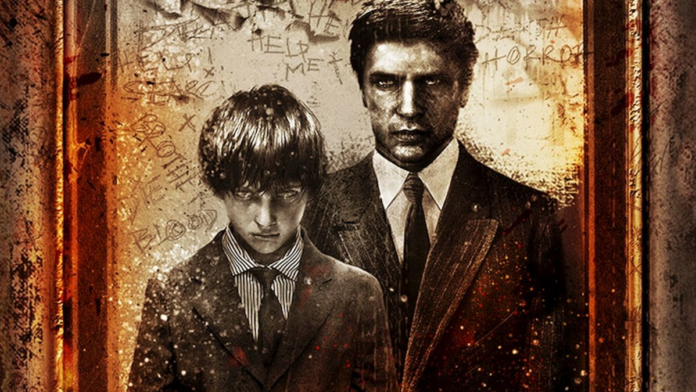Developed by US-based The Collective (which had merged with another company to become Double Helix by the time the game was released), Silent Hill: Homecoming follows Alex Shepherd, a recently discharged US soldier who returns to his hometown of Shepherd’s Glen to find it disturbingly altered. The empty streets are falling apart, his mother is catatonic, and his little brother Josh is missing. Vowing to recover his younger sibling, Alex’s descent into madness sees him uncovering the hideous connection between Shepherd’s Glen and Silent Hill, while learning how the ties that bind can also cut.
Put into production at roughly the same time as Origins and released on PS3, Homecoming was Konami’s first true attempt to give the series the triple-A treatment. “[For Konami US] it was like, ‘Homecoming is the Big One,'” recalls Tomm Hulett, who worked as a producer on most of the Western Silent Hill games. “[They were saying,] ‘This is Silent Hill Five: it’s going to be the first one on a next-gen platform, it’s going to be where you can finally get to see Silent Hill in HD and so on.'”
With this ambition in mind, it was clear that fixed cameras and tank controls wouldn’t cut the mustard, especially for a survival horror title in the post-Resident Evil 4 world.
“Design-wise, there was a lot of thought about ‘How do we modernise this?'” recalls Hulett. “Because at the time survival horror was changing. ‘How action-oriented do we get?’ People might not remember, but Resident Evil 4 was really controversial within the Resident Evil fanbase. There were questions about whether it was even survival horror any more. So when we asked ourselves whether we should follow in those footsteps we decided, ‘Well, probably not – we should do our own thing.’ But then that raised the question, ‘What is our new thing? How do we make this game not old? What’s there for tradition, and what shouldn’t be there because it’s outdated?'”
Silent but deadly
(Image credit: Konami)
Zero to hero (Image credit: Konami) What about the PSP prequel? 17 years on, Sam Barlow reflects on Silent Hill: Origins: “To pull it out of the bag with a seven-out-of-ten game was incredibly rewarding”
The answer was something of a compromise between old and new. As in the original Silent Hills, ammo and healing kits are generally scarce, the HUD is mostly nonexistent, and the inventory lacks any sort of management mechanic. At the same time, Alex is controlled from a fully third-person perspective, the game features a quick-select weapon wheel, and aiming with firearms uses the over-the-shoulder Resi 4 method. The biggest gameplay shakeup is the close combat. Being a military veteran, Alex is no slouch when it comes to a punchup and can chain together basic one-two combos, perform finishers, and even duck back with a handy dodge move.
“[The Silent Hill games] were always designed with combat in them,” says Brian Horton, lead artist and core member of Homecoming’s creative team. “So we decided if that was an element in the games, we’d want to have something that felt survival-ly and not be too overpowering. We were really striving to come up with a system where skill felt important, and defensive moves allowed you to keep in the fight as much as possible. We were trying to figure out that feeling of a true spar.”
(Image credit: Konami)
When it came to Homecoming’s other elements, the developers took a more tried-and-true approach. Early in development the game was to be connected directly to the established lore, as the first in a trilogy that would see the story culminate in a “Super Saiyan” (Hulett’s words) battle between Alessa Gillespie and Josh over Toluca Lake.
Sign up to the GamesRadar+ Newsletter Weekly digests, tales from the communities you love, and more Contact me with news and offers from other Future brands Receive email from us on behalf of our trusted partners or sponsors
While this idea was mercifully dropped, Homecoming’s story nonetheless still focusses on the existing lore of the cult. And it features series’ hallmarks, including the fog world, rust-and-blood otherworld, and iconic monster designs such as the Nurses, an equivalent to Lying Figure, and – controversially – Pyramid Head, here renamed the Bogeyman.
Like Origins’, Homecoming’s reviews tended to hover at around seven out of ten, with a consensus that the game was a solid, if somewhat predictable, entry in the series. Fans can certainly have fun with the game, and for those who enjoyed Christophe Gans’ 2006 Silent Hill movie (from which Homecoming’s art direction took inspiration), the game is a visual treat. Still, to date no developers had attempted to reimagine Silent Hill from the ground up. That would all change with the next game: Silent Hill: Shattered Memories.
This feature originally appeared in PLAY Magazine – which printed its final issue in 2024. Feeling like braving the titular town’s foggy and dangerous streets? Then check our best Silent Hill games list!




